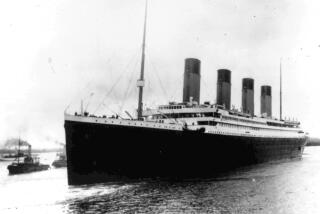Seeing Titanic an “Eerie Feeling,” Navy Officers Say
- Share via
The visage and arms of a statue of the Greek god Titan, buried face-up in the ocean bottom, greeted two U.S. Navy officers who guided the underwater robot that photographed the fabled liner Titanic, they recalled Friday.
The sunken remains of the ship appeared initially as a large shadow floating in the murky depths of the Atlantic, Lts. Brian K. Kissel and Mike D. Mahre said at a San Diego news conference.
Then suddenly a large wall of rust, along with artifacts of various hues and shades--including the statue, which was the mascot of the ship--came into sharp focus, and researchers realized that they were peering into the remnants of a small city where all but 700 of the 2,200 inhabitants perished, Kissel said.
“For me, I saw spring coils from the inside of a mattress and realized, ‘Hey, people slept on those,’ ” Kissel said.
“It’s an eerie feeling, like looking into someone’s grave, though there are no bodies,” added Mahre, Kissel’s colleague at the Navy Submarine Development Group in San Diego.
Mahre and Kissel were among the privileged few afforded a glimpse of the Titanic last month during tests of a new deep-ocean unmanned surveillance vehicle dubbed Jason Jr. The two men were trained as pilots to guide the submersible from the Alvin, a larger underwater vehicle to which Jason Jr. was attached by a 250-foot tether.
The robot, developed jointly by the Navy and the Woods Hole Oceanographic Institution in Massachusetts, was able to dart in and out of the Titanic’s side into kitchens and staterooms, through the broken skylight of the grand staircase for a view into the main ballroom, and around corners deep below decks to find dinnerware, cups and other artifacts of the Titanic’s ill-fated first and only voyage.
Mahre and Kissel trained at Woods Hole in June to pilot Jason Jr. The only difficult aspect of its remote operation, they said, was to avoid snagging the connecting tether on the metal stalactites that protrude throughout the bow section of the Titanic.
“We built an obstacle course in a pool at Woods Hole and put (Jason Jr.) in there to practice moving it around and avoiding (obstacles),” Mahre said.
On the expedition, the three-person vehicle Alvin was lowered 12,800 feet from a surface command ship to a flat area of the Titanic’s deck, and the Jason Jr. was then detached.
For Mahre and Kissel, the impact of the Titanic temporarily overshadowed the main purpose of the Jason Jr.’s test: to perfect a deep-ocean robot that can “see” at depths that make manned submersibles highly difficult or unfeasible to operate.
“This is more or less good for my future training,” Mahre said, “since deep submersible training is what we do” at the Submarine Development Group.
Although biologists already plan to use the Jason Jr. and more advanced models to examine underwater thermal vents and other oceanic mysteries, the Navy clearly envisions military applications for the robots.
Mahre said that such robots could be much better than sonar in mapping underwater terrain. In addition, Naval scientists in Washington have previously said that lost submarines and enemy underwater devices could be probed, and perhaps suitable underwater locations for missile platforms could be found.
The testing last month involved the Jason Jr.’s system of cameras and its machinery designed for high maneuverability. Scientists hope to test a larger robot, called Jason, within several years. It will be controlled from a surface ship, eliminating the need for any manned submersible to first descend and release it.
As a result, the opportunity afforded Mahre and Kissel--to see with their own eyes what the robot saw--may well be the last.
“It’s really not practical to put man into that environment,” Mahre acknowledged. “You can accomplish the same thing with a robot.
“Personally, I think it would be (nice to be) able to see something with our own eyes and and be able to guide the robot on the spot, but really, why send a man 13,000 feet down when the (robot) is available?”
More to Read
Sign up for Essential California
The most important California stories and recommendations in your inbox every morning.
You may occasionally receive promotional content from the Los Angeles Times.













